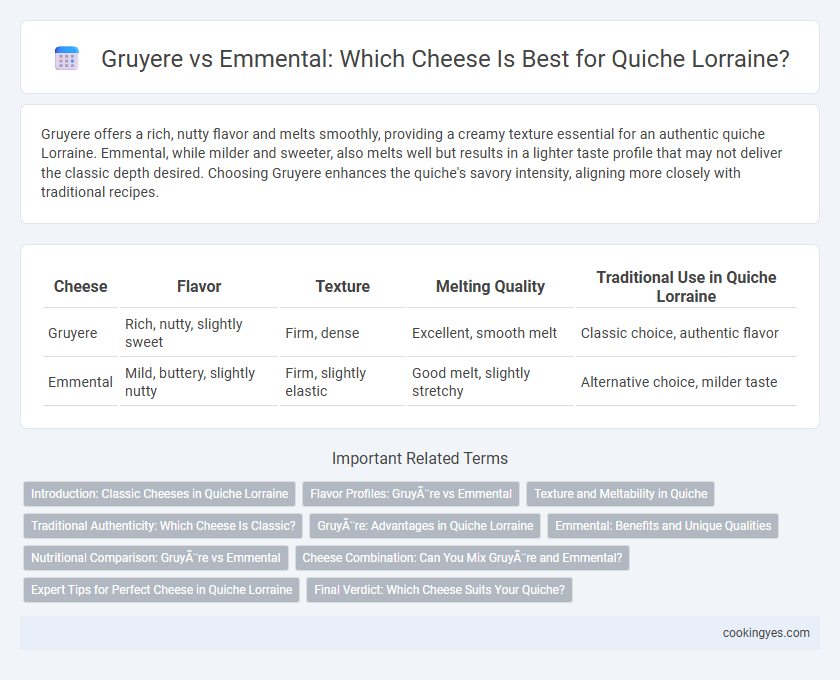Gruyere offers a rich, nutty flavor and melts smoothly, providing a creamy texture essential for an authentic quiche Lorraine. Emmental, while milder and sweeter, also melts well but results in a lighter taste profile that may not deliver the classic depth desired. Choosing Gruyere enhances the quiche's savory intensity, aligning more closely with traditional recipes.
Table of Comparison
| Cheese | Flavor | Texture | Melting Quality | Traditional Use in Quiche Lorraine |
|---|---|---|---|---|
| Gruyere | Rich, nutty, slightly sweet | Firm, dense | Excellent, smooth melt | Classic choice, authentic flavor |
| Emmental | Mild, buttery, slightly nutty | Firm, slightly elastic | Good melt, slightly stretchy | Alternative choice, milder taste |
Introduction: Classic Cheeses in Quiche Lorraine
Gruyere and Emmental are the quintessential cheeses used in traditional quiche Lorraine, each bringing distinct textures and flavors to the dish. Gruyere offers a rich, nutty taste that melts into a creamy consistency, enhancing the quiche's savory profile. Emmental provides a milder, slightly sweet flavor with excellent melting qualities, contributing to a smooth and airy quiche filling.
Flavor Profiles: Gruyère vs Emmental
Gruyere offers a rich, nutty, and slightly sweet flavor that melts smoothly, making it a classic choice for Quiche Lorraine. Emmental provides a milder, more buttery taste with characteristic large holes, contributing a lighter texture without overpowering other ingredients. Choosing Gruyere enhances the depth and complexity of the quiche, while Emmental yields a gentler, creamier flavor profile.
Texture and Meltability in Quiche
Gruyere cheese offers a dense, creamy texture with excellent meltability that creates a rich, smooth filling in Quiche Lorraine. Emmental provides a lighter, slightly spongy texture with a milder melt, resulting in a less custardy consistency. The choice between Gruyere and Emmental significantly impacts the quiche's overall texture, with Gruyere favored for its superior melt and luxurious mouthfeel.
Traditional Authenticity: Which Cheese Is Classic?
Gruyere is the classic cheese traditionally used in authentic quiche Lorraine, prized for its rich, nutty flavor and smooth melting quality that enhances the custard base. Emmental, while commonly used as an alternative, imparts a milder, slightly sweeter taste that deviates from the original recipe's robust character. Culinary historians and classic French recipes consistently highlight Gruyere as the definitive cheese for maintaining traditional authenticity in quiche Lorraine.
Gruyère: Advantages in Quiche Lorraine
Gruyere cheese is preferred in Quiche Lorraine for its rich, creamy texture and complex flavor profile that enhances the savory custard filling without overpowering other ingredients. Its excellent melting properties create a smooth, cohesive consistency that is key to the quiche's signature silky mouthfeel. Compared to Emmental, Gruyere offers a nuttier, more robust taste, making it the ideal choice for achieving authentic, balanced flavor in classic Quiche Lorraine.
Emmental: Benefits and Unique Qualities
Emmental cheese brings a mild, nutty flavor and excellent melting properties to quiche Lorraine, creating a smooth, creamy texture that blends seamlessly with eggs and bacon. Its distinctive holes, or "eyes," indicate the fermentation process, contributing to its unique taste and lightness. Emmental's lower fat content compared to Gruyere makes it a slightly healthier choice without compromising the rich flavor essential to traditional quiche Lorraine.
Nutritional Comparison: Gruyère vs Emmental
Gruyere cheese contains approximately 413 calories and 33 grams of fat per 100 grams, with higher protein content at around 30 grams, making it a rich source of energy and muscle-building nutrients for quiche Lorraine. Emmental cheese has slightly fewer calories, about 380 per 100 grams, and lower fat content around 29 grams, but it offers a similar protein level of approximately 28 grams, providing a lighter yet still nutritious option. Both cheeses contain essential minerals like calcium and phosphorus, but Gruyere typically delivers a richer flavor and denser nutritional profile, enhancing the taste and nutrient density of quiche Lorraine.
Cheese Combination: Can You Mix Gruyère and Emmental?
Gruyere and Emmental complement each other in Quiche Lorraine by combining Gruyere's rich, nutty flavor with Emmental's mild, slightly sweet taste, enhancing the overall cheese profile. Mixing these Swiss cheeses creates a balanced texture, as Gruyere melts smoothly while Emmental offers a creamy consistency with subtle holes. This combination elevates the quiche's savory depth, making it a popular choice for achieving a perfectly harmonious and flavorful filling.
Expert Tips for Perfect Cheese in Quiche Lorraine
Gruyere provides a rich, nutty flavor with excellent melting properties that enhance the creamy texture of Quiche Lorraine, making it a top choice among culinary experts. Emmental, while milder and sweeter, offers a lighter cheese profile that melts smoothly but may lack the depth of flavor typically sought in traditional recipes. For a perfect Quiche Lorraine, experts recommend using high-quality Gruyere aged at least six months to achieve the ideal balance of taste and texture.
Final Verdict: Which Cheese Suits Your Quiche?
Gruyere offers a rich, nutty flavor and creamy texture that enhances the classic Quiche Lorraine, creating a balanced and indulgent bite. Emmental provides a milder, slightly sweet taste with excellent melting properties, ideal for those who prefer a less intense cheese flavor. For a traditional and robust quiche, Gruyere is the optimal choice, while Emmental suits lighter, more subtle variations.
Gruyère vs Emmental for quiche Lorraine Infographic

 cookingyes.com
cookingyes.com